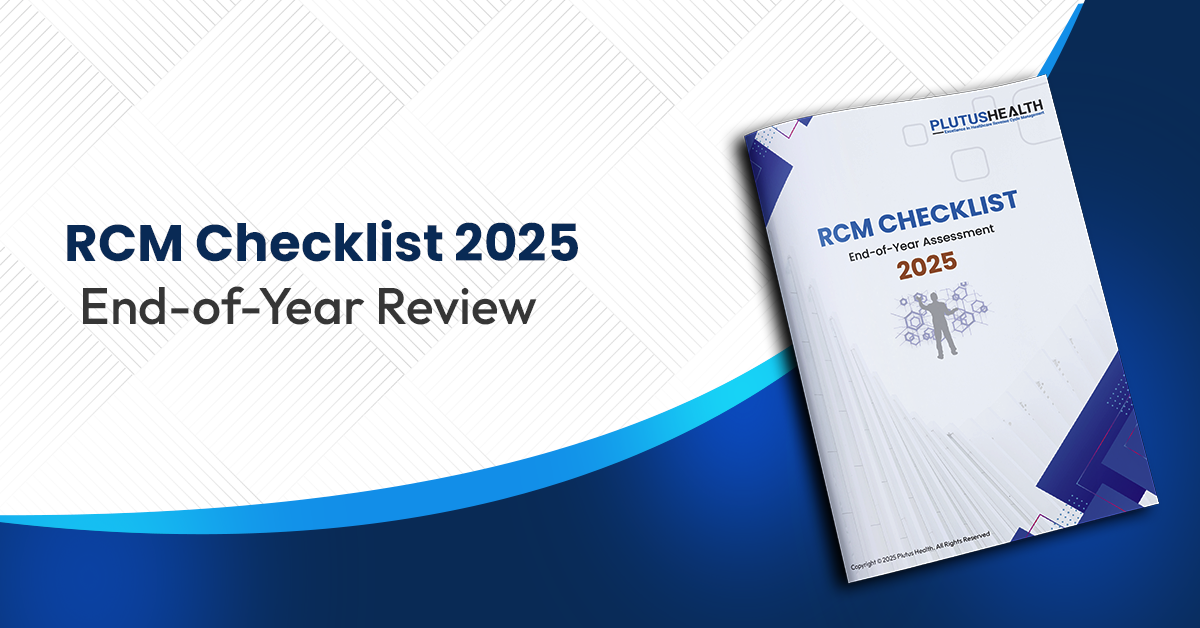5 Steps to Supercharge Your RCM for 2025 Success
Meet Sarah, the CFO of a mid-sized healthcare provider. By end of January 2024, her team was already drowning in denied claims, delayed reimbursements, and a mountain of unverified patient data. Their AR days hovered at 52, and the denial rate was a staggering 15%. Sarah knew they couldn’t survive another year like this.
Enter Plutus Health. Through strategic changes focusing on Eligibility Verification (EV), Benefits Verification (BV), and Insurance Discovery (ID), Sarah’s team slashed AR days to 32, reduced denials by 50%, and unlocked an 18% increase in collections.
Here’s how you can do the same.
Step 1: Start with Accurate Eligibility Verification (EV)
Why It Matters:
Did you know that 23% of all claim denials are due to eligibility errors? Missing or incorrect insurance information can lead to costly rework and delayed payments.
What to Do:
- Use automated tools to verify insurance details in real time.
- Validate secondary and tertiary insurance coverage upfront.
- Cross-check demographic details against payer systems.
Results We’ve Seen:
- Reduced eligibility-related denials by 68%.
- Improved upfront collections by 15%.
Step 2: Simplify Benefits Verification (BV)
Why It Matters:
Patients are responsible for a growing share of healthcare costs, with out-of-pocket expenses increasing by 29% over the last five years. Verifying benefits accurately ensures your team collects what’s owed, without surprises for patients.
What to Do:
- Automate BV to calculate patient responsibilities and provide upfront estimates.
- Integrate BV tools into your scheduling and billing systems for seamless workflows.
- Offer clear communication to patients regarding their financial responsibilities.
Results We’ve Seen:
- 20% increase in patient payment collections.
- 10% boost in patient satisfaction scores due to transparency.
Step 3: Master Insurance Discovery (ID)
Why It Matters:
In a perfect world, all patient insurance information would be accurate at the point of care. In reality, 18% of claims are delayed due to missing or incorrect insurance details.
What to Do:
- Leverage AI-powered insurance discovery tools to identify active coverage.
- Conduct batch processing to validate large patient volumes efficiently.
- Use predictive analytics to flag potential discrepancies before they become claims issues.
Results We’ve Seen:
- Identified 99% of active payers through automated coverage discovery.
- Accelerated claims submission by 30%.
Step 4: Broaden Your RCM Strategy
Why It Matters:
While EV, BV, and ID are critical, they’re just the beginning. A broader RCM strategy ensures your team operates efficiently across the entire revenue cycle.
What to Do:
- Implement predictive analytics to forecast cash flow and prioritize high-value claims.
- Automate claims scrubbing and denial management for faster resolutions.
- Monitor key metrics like AR days (DSO), denial rates, and net collection rate (NCR) to identify trends and course-correct.
Results We’ve Seen:
- Reduced AR days to under 35 for most clients.
- Increased net collection rates to 96% or higher.
Step 5: Prepare for 2025 Trends
Why It Matters:
Healthcare is evolving rapidly, and staying ahead of trends ensures your organization remains competitive.
Key Trends for 2025:
- AI-Powered Workflows: Automate routine tasks to free up staff for higher-value activities.
- Patient-Centric Billing: Improve patient satisfaction with clear, transparent billing processes.
- Hybrid Models: Combine AI-driven efficiencies with human expertise for the perfect balance.
Your Free RCM Checklist for 2025
Ready to supercharge your revenue cycle? Download our free checklist to assess your RCM processes and build a roadmap for success in 2025.
Start the Year Strong with Plutus Health
At Plutus Health, we’ve helped hundreds of providers like Sarah turn their RCM challenges into opportunities. Let us help you streamline your processes, increase collections, and reduce inefficiencies.
Liked the blog? Share it
FAQs


ABA providers are grappling with high staff turnover (up to 65%), rising burnout, administrative overload, and stagnant reimbursement rates. These challenges directly impact care continuity, clinical outcomes, and operational performance.


Operational inefficiency costs ABA teams up to 10 hours per staff member per week, contributing to burnout, denied claims, and longer accounts receivable (A/R) cycles. These inefficiencies ultimately result in reduced revenue and patient dissatisfaction.


Burnout leads to costly turnover, lower client retention, and decreased productivity. Recruiting and replacing a BCBA or RBT can cost up to $5,000 per hire, plus months of lost revenue and disruption to morale.


High-performing ABA organizations invest in clear career pathways for BCBAs and RBTs, align compensation with market benchmarks, and foster peer-led mentorship, flexible schedules, and wellness programs.


Automation tools like Plutus Health's Zeus streamline eligibility verification, denial management, and billing, reducing manual workloads by 5–10 hours weekly per clinician and improving clean claim rates by 95%.


Outsourcing revenue cycle management can improve collections, reduce denials by up to 30%, and free clinicians from billing-related admin tasks, resulting in better client care and financial outcomes.


One $200 million ABA network partnered with Plutus Health to automate eligibility and accounts receivable (A/R) processes. The result: $2M reduction in legacy A/R and a 97% Net Collection Rate.


By improving operational efficiency, investing in technology, and ensuring workforce stability, ABA leaders can align outcomes with reimbursement. Plutus Health supports this transition with scalable RCM and automation strategies.
FAQs


ABA therapy billing is the process of submitting claims to insurance or Medicaid for Applied Behavior Analysis services provided to individuals with autism or developmental disorders. It includes using correct CPT codes, proper documentation, and adherence to payer-specific policies.


Common CPT codes for ABA therapy in 2025 include:
- 97151 – Assessment and treatment planning
- 97153 – Direct therapy with the patient
- 97155 – Supervision and modification of behavior plan
- 97156 – Family adaptive training
- Always check with payers for any annual changes.


To bill Medicaid for ABA services, providers must ensure credentialing is complete, services are pre-authorized, and claims use the correct codes and modifiers. Medicaid requirements vary by state, so always follow state-specific billing rules.


Common ABA billing mistakes include:
- Incorrect or missing CPT codesplan
- Lack of documentation or treatment
- Uncredentialed providers rendering services
- Submitting duplicate or late claims


Without proper credentialing, providers can’t get reimbursed. Insurance and Medicaid require that BCBAs, RBTs, and organizations are credentialed and contracted. Delays in credentialing often cause revenue losses and claim rejections.
FAQs


CMS proposes a 2.4% increase in Medicare ASC payment rates, contingent on meeting ASCQR quality reporting requirements. Plutus Health helps ASCs meet these compliance benchmarks by integrating quality reporting data into RCM workflows, ensuring eligibility for full payment updates.


The ASC Covered Procedures List will expand by 547 procedures, including cardiology, spine, and vascular surgeries. Plutus Health supports expansion into new service lines by customizing RCM processes for high-acuity procedures, minimizing claim denials during the transition.


Site-neutrality narrows the payment gap with hospital outpatient departments, enhancing ASCs' cost-efficiency appeal. Plutus Health helps leverage this advantage in payer negotiations by providing performance dashboards and cost-justification analytics to secure stronger reimbursement terms.


Complex procedures increase denial risk and slow cash flow. Plutus Health's automation-first RCM model delivers 95%+ clean claim rates, reduces A/R days, and safeguards margins, even as your case mix becomes more complex.
FAQs


A hybrid RCM model combines in-house tasks like scheduling, intake, and patient communication with outsourced billing support for claims, denials, and A/R follow-up. Plutus Health enables this model with automation and expert teams.


Frequent CPT code updates, variable session lengths, high no-show rates, and sensitivity around patient collections make behavioral health billing uniquely challenging. Hybrid RCM helps strike a balance between compliance and patient care.


Tasks requiring patient interaction—like intake, eligibility checks, copay collection, and documentation—are best kept in-house, while backend processes can be outsourced.


Outsourcing denial management, claims scrubbing, and payment posting improves clean claim rates, reduces A/R days, and scales capacity without adding staff.


Plutus Health delivers 97%+ clean claim rates, AI-powered denial prediction, and 48-hour claim turnaround. Our hybrid RCM solutions provide behavioral health CFOs with visibility and control, while enhancing financial performance.
FAQs


Payment complexity, high out-of-pocket costs, increasing denials, and value-based care requirements are pushing providers toward more transparent, tech-supported payment systems.


Patients now act like consumers. They expect clear cost estimates, simple bills, digital payment options, and flexible financing.


AI, automation, and digital tools streamline estimates, reduce denials, support payment plans, and allow faster collections through mobile and online payments.


Complex billing questions, insurance confusion, and financial stress require a compassionate approach. Advocates guide patients and protect trust in clinical care.


Plutus Health supports providers with AI-driven denial prevention, predictive analytics, digital payment tools, patient financing, and a seamless platform, such as AnodynePay.















































